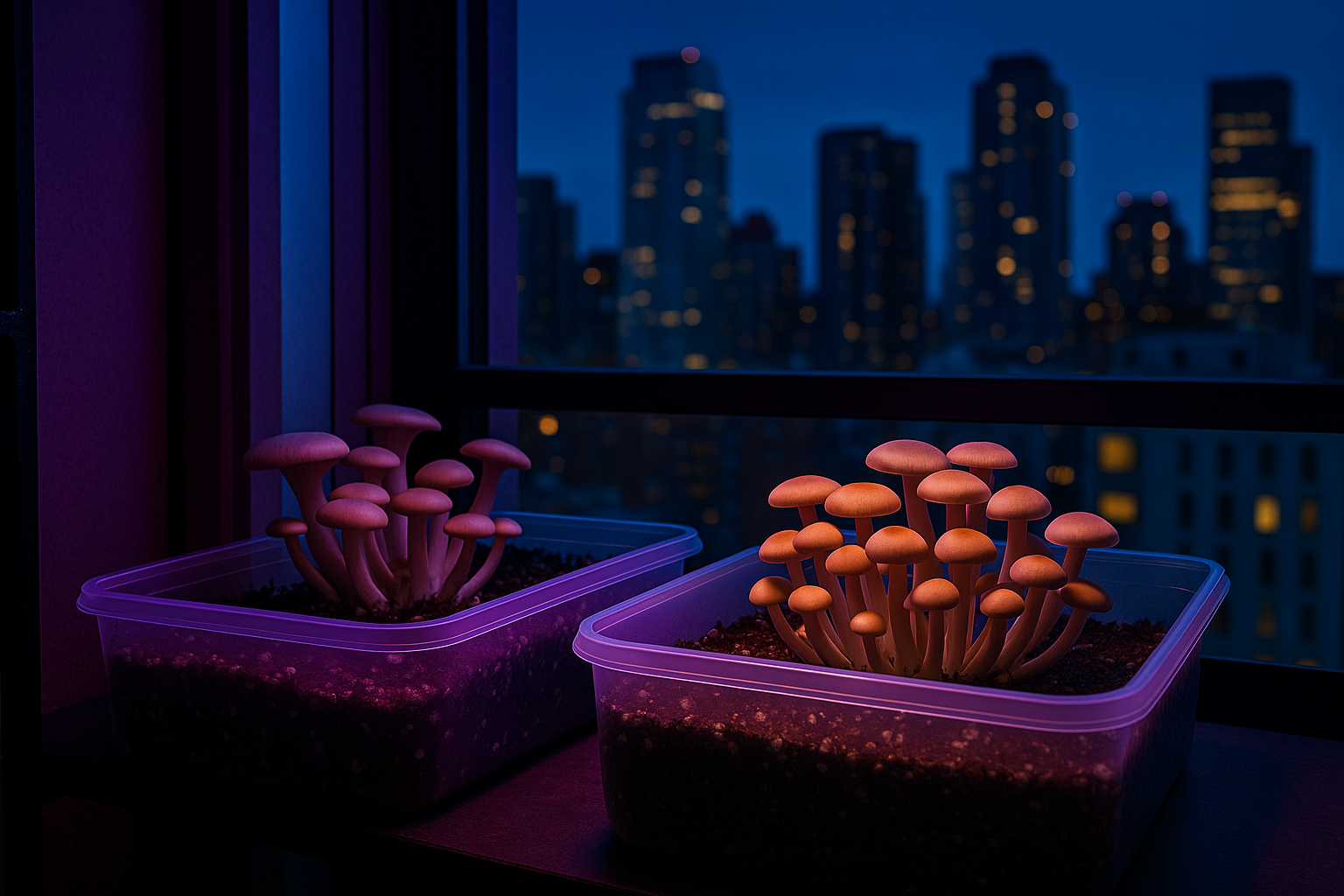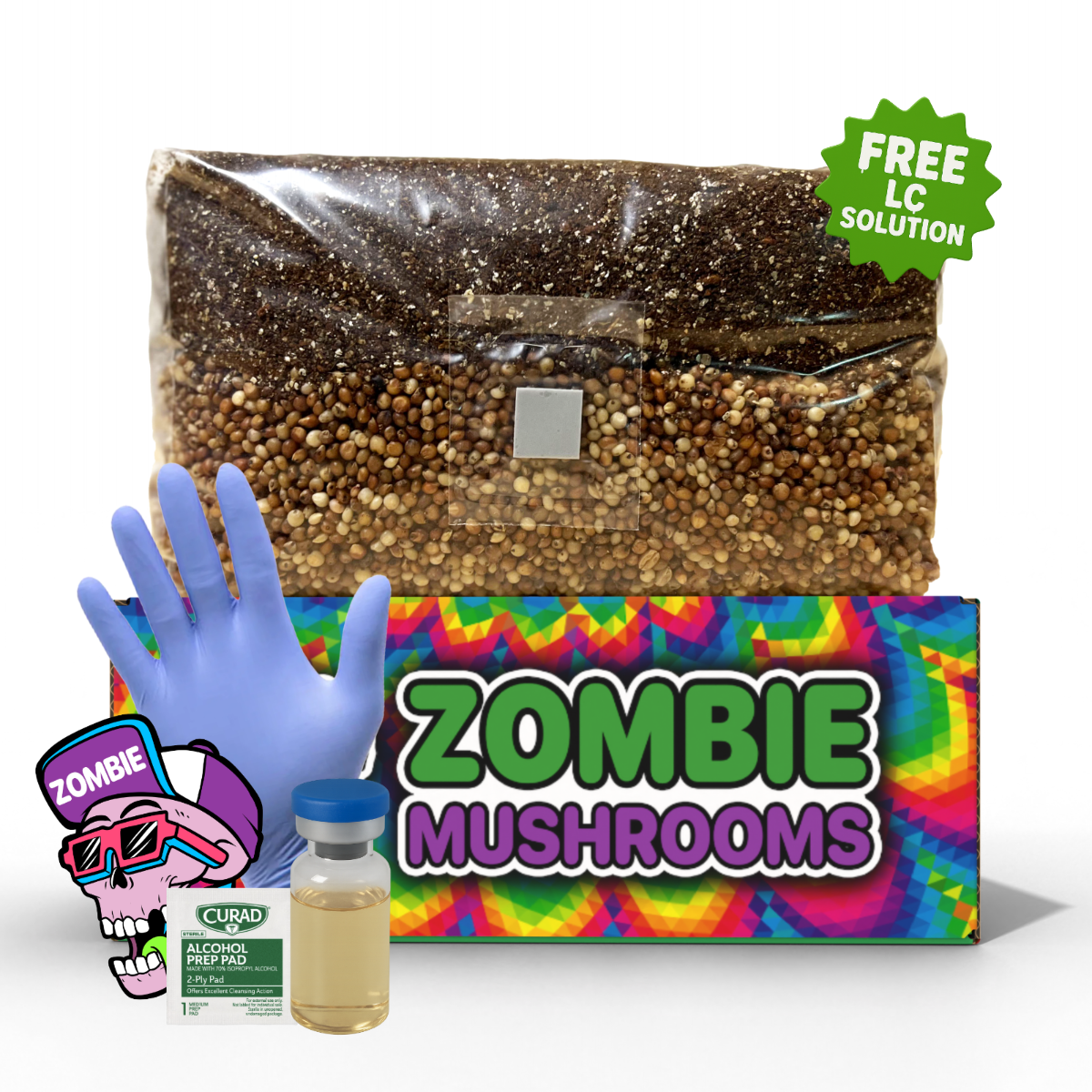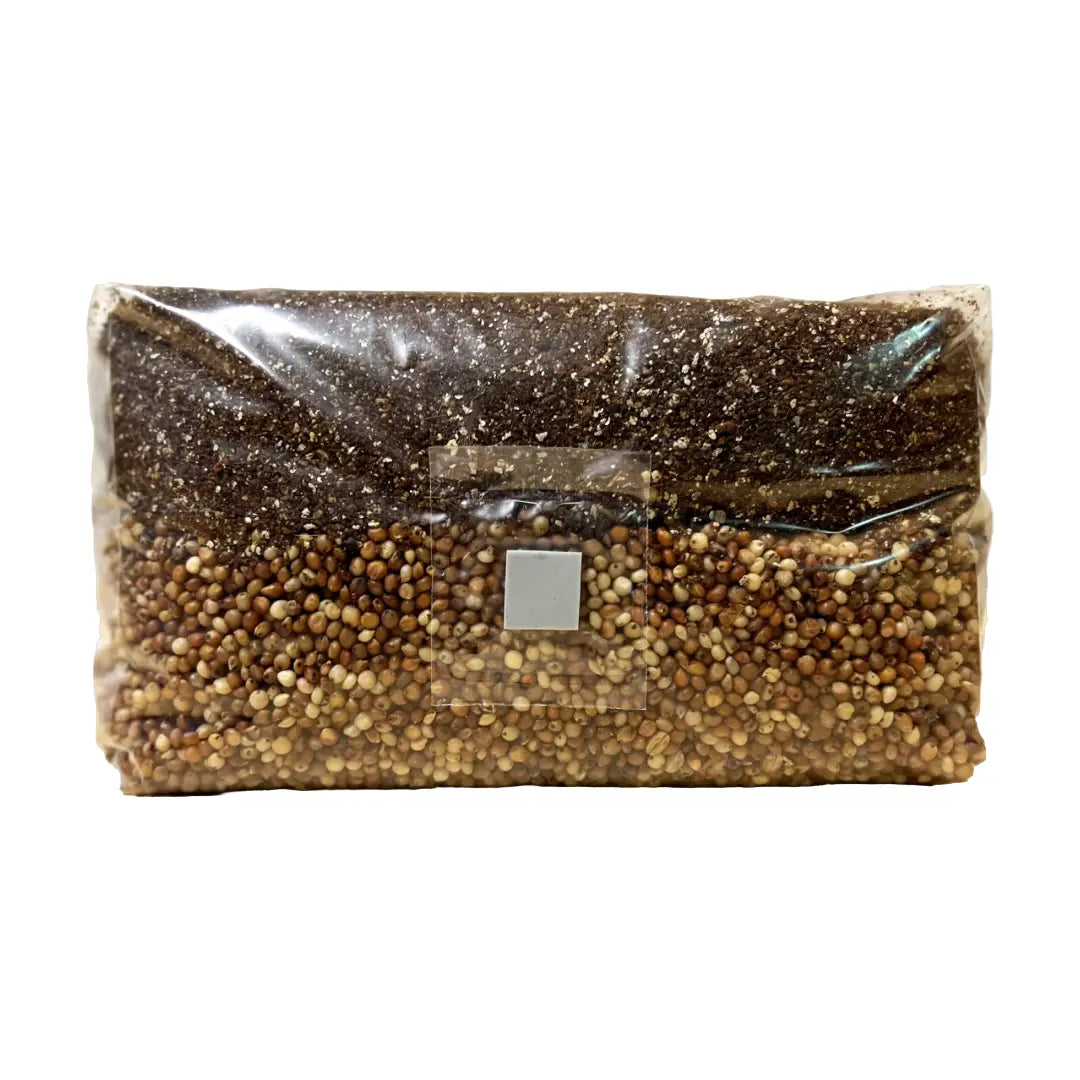⬇️ Prefer to listen instead? ⬇️

- ⚠️ Psilocybin remains federally illegal, despite localized decriminalization.
- 💡 Filtered or distilled water greatly improves mushroom cultivation success.
- 🐾 Pets can contaminate or be harmed by homegrown shrooms if not kept away.
- 🌱 Proper airflow and humidity control are vital for healthy mushroom yields.
- 🔒 Online posts about homegrown shrooms can expose cultivators to legal risk.
⚠️ Disclaimer: This article is for educational purposes only. Zombie Mushrooms does not condone, promote, or encourage the cultivation or use of illegal substances. We provide information to support legal, responsible mushroom growing practices and only sell supplies intended for gourmet and medicinal mushroom cultivation.
Psilocybin mushrooms have gained popularity for their potential therapeutic uses, especially in treating depression, anxiety, and PTSD. But besides their clinical promise, many urban dwellers are learning how to grow mushrooms at home. While growing your own supply of homegrown shrooms can be a good thing to do, it takes skill, knowing the rules, and being careful. This guide tells you everything you need to know to grow psilocybin mushrooms safely and responsibly in your own space, including how mushroom monotub kits can simplify the process for beginners.
Legal Disclaimer: Understanding the Risks Before You Grow
Before starting any mushroom growing project, it's important to know the legal rules in your region. Although more cities in the United States have moved toward decriminalization, psilocybin is still a controlled substance at the federal level. This means growing psilocybin mushrooms can still lead to big legal problems—even in places that have said they won't prioritize chasing growers.
As of 2023, cities such as Denver, Oakland, Santa Cruz, and San Francisco have taken steps to decriminalize owning and using psilocybin for yourself. But these local rules often don't mean you can legally grow them. Also, state and federal authorities can still make people follow laws. This is especially true if growers talk about what they are doing online. Check your local laws and don't post about this online. That will help you stay out of trouble [Municipal Code of Denver, 2023].

The Urban Grower’s Setup: Small Space, Big Considerations
Growing mushrooms indoors—especially in small apartments—needs careful planning. Urban growers often don't have much space or greenhouses. So they need small, clean, and efficient grow setups.
Here's what a simple but good setup might have:
- A grow tent or clear plastic tub with ventilation holes
- A hygrometer and thermometer to check the environment right away
- A small fan that moves back and forth to increase airflow and lower the chance of contamination
- Indirect light sources to act like natural cycles
Humidity is very important. For psilocybin mushroom types like Psilocybe cubensis, keeping the humidity between 85%–95% during the fruiting stage is key. Growers often use perlite or misting to keep levels right. Bad airflow along with high humidity helps contaminant molds grow. These molds can ruin your yield and put things that cause allergies into your home.
Lighting is not as hard, but still important. Mushrooms don't need photosynthesis, but normal light—best if it's like daylight—helps tell the mushrooms when to grow. Don't put your grow area in direct sunlight because the heat can cause changes that hurt the mycelium.

DO: Use Filtered or Distilled Water for Your Grow
Water is life—for you and for your mushroom cultures. Water from the city tap is usually safe for people, but it often has chloramine, chlorine, and fluoride. These can hurt sensitive fungal parts like mycelium.
Using distilled or filtered water can really help mycelium stay healthy and stop contamination. Another cheap way is letting tap water sit without a lid for 24–48 hours. This lets things like chlorine disappear on their own [Sublette & Ribaudo, 2022].
Doing this makes sure you aren't accidentally hurting your grow by using bad water. Clean water helps the mycelium spread fast and leads to more mushrooms.
Pro Tip:
Clean your water containers and misting bottles so you don't bring in germs. Everything about growing your mushrooms—like the substrate and the water—should be clean and sterile.
DON’T: Let Your Pets Near Your Cultivation Area
A curious cat might seem harmless, but pets are a real risk to your mushroom operation. Animal fur and dander can bring in germs that can ruin your grow. Even a quick sniff from a dog or a paw swipe from a cat can cause mold to grow everywhere.
Even worse, if pets eat the mushrooms, it can be very bad for them. They might vomit, have seizures, or even go into a coma or die. Vet visits for this type of poisoning are expensive and sad.
Make your grow zone safe with:
- Lidded containers
- Grow shelves in a closet
- Baby gates or doors you can lock
- High places pets can't reach
Taking these steps protects your grow and your pets.

DON’T: Dry Mushrooms in Piles or Expose Them to Too Much Moisture
How you handle mushrooms after picking is a common reason they go bad. Mushrooms piled up hold moisture. This causes bacteria to grow, mold, and psilocybin becoming weaker. Not drying them right also means they won't last long and won't be safe.
Instead, try one of these ways to dry them:
- Food Dehydrator (90–110°F): This is the best way to dry them evenly and fast.
- Desiccant Chamber: Use silica gel in a container that seals tight to dry them more after you get most of the water out.
- Mesh or Screen Rack: Let them air dry in a cool, dry room with good air movement before you put them away.
Your dried mushrooms should "snap" instead of bend when they are completely dry. If they feel rubbery, you're making them go bad. Properly dried mushrooms kept sealed can stay potent for 6 to 12 months or more if you keep them in a dark, airtight container with oxygen absorbers and things that soak up moisture.

DO: Play Music or Maintain a Positive Vibe
There's no proof in science, but many mushroom growers think fungi can sense vibrations and energy. People might think music helps mushrooms grow because some studies show plants react to sound.
Keeping your grow space clean and having a good feeling about it helps in other ways. When you spend time watching your grow, you're less likely to miss signs of contamination or other problems.
Think of this as part of how you live: growing mushrooms is about watching, being consistent, and gently helping them. It's a good idea to write down what you use, the conditions, and how things turn out. This helps you get better results next time.
DON’T: Overshare Your Grow with the Internet
You might want to show off your mushrooms on Instagram or Reddit—but don't. Talking about it too much puts you at needless legal risk, even in cities that have decriminalized them. Photos can have data that shows where and when you took them. This could be used to start a criminal investigation if someone finds out.
Keep in mind, growing psilocybin is still against the law at the federal level in the United States. Even writing helpful comments can sometimes get people asking questions.
Using anonymous forums, hiding identifying details in photos, and not saying where you are is the least you should do to be careful online. Even better—keep your grow project private and don't tell anyone.

Mushroom Cultivation Tips for Conditions and Space Efficiency
One of the biggest problems getting started for urban mushroom growers is having little space. From closets to kitchen counters, many small spaces can work well if you use the right tools and do things efficiently.
Tips:
- Pick strains like Psilocybe cubensis. They are good for beginners.
- Choose all-in-one grow kits. They often filter air on their own and are small.
- Put shelves one above the other to use space best.
- Keep things like substrate and drying tools in bins that fold up.
Tools that use little energy, like small LED grow lights and incubators that control humidity, work better and use less power. Companies like Zombie Mushrooms have simple ways to grow mushrooms made for people with small spaces. They offer tools that are discreet and last long.

Understanding the Mushroom Life Cycle to Prevent Mistakes
Knowing how mushrooms grow will really help you get a good harvest. Here are the stages of the mushroom life cycle:
- Spore Germination – Spores turn into thin threads called mycelium in a sterile place.
- Colonization – Mycelium grows through the substrate (food source). It makes a white network.
- Pinning – Changes in the environment make small pins grow. These are young mushrooms.
- Fruiting – Pins grow into full mushrooms when humidity, light, and airflow are just right.
- Harvest – You pick mushrooms right when their caps start to open.
Things that show contamination: green spots (that's Trichoderma mold), black areas, a sour or bad smell, or feeling slimy. Healthy mycelium is white and smells like earth. It shouldn't have a strong, bad smell.
When you do things is very important. If you pick too late, spores will drop. This makes contamination more likely. If you pick too early, you won't get as many mushrooms, and they won't be as strong.

Legal and Ethical Responsibility in Psychedelic Cultivation
Growing something that can affect your mind isn't just a hobby. It's a responsibility. Using your homegrown mushrooms without knowing the right amount to take, how to handle the experience, or potential mental health risks could hurt more than it helps.
Sharing or selling your mushrooms, even to friends, is also questionable ethically and usually against the law. Handle every trip with care: know what you're getting into, be in a safe place, and be mentally ready. These are all key parts.
Groups like MAPS.org and the Psychedelic Society have great information if you're thinking about using them for therapy. Make knowing the facts and being safe just as important to your mushroom growing as any other skill you learn.

Storage and Safety: Keeping Your Home and Supply Secure
After your mushrooms are dry, storing them right is very important. To keep them strong and stop accidents, you need specific ways to store them:
- Use containers that seal tight and are labeled (like mason jars with things to soak up moisture)
- Keep them in a dark, dry spot away from sun and heat
- Keep the containers locked or where kids, pets, or unexpected visitors can't get them
- Think about vacuum sealing for storing them a long time
Besides safety, storing them right also means less waste because they won't go bad. See storage as the last step in growing your mushrooms.

Why Zombie Mushrooms Is a Safe Choice for Urban Cultivators
Zombie Mushrooms has everything both new and experienced growers need. It's made for growing in city spaces. Their kits are easy to use and come with sterilized grain bags, substrate mixed already, grow chambers that let air in, and things that help stop contamination.
Why Zombie Mushrooms is a good choice:
- Lab-made liquid cultures that are very clean, so you get the same results.
- Products made to fit on shelves, in closets, and other indoor places.
- Kits that last and take very little time to set up.
- Support in the U.S. if you have questions or problems.
From starting your grow to picking the last mushrooms, Zombie Mushrooms helps growers with good materials and guides that are easy to follow. This makes growing mushrooms at home easier, safer, and more successful.
Responsible, Safe, and Fun Mycology at Home
Growing mushrooms is not just a trend. It's a science, an art, and something people do for wellness. If you do it right, growing psilocybin mushrooms can make you feel capable, save you money, and offer ways to feel better. If you don't do it right, it can cause legal problems, health issues, and safety risks for people and pets.
If you're interested in the science of growing or what psilocybin can do for your mind, take the time to do it the right way. Learn. Get ready. Try things out safely. Most important—respect how powerful these old fungi can be.
Related Resources for Mushroom Growers
General Mushroom Growing Guides
Citations:
Davis, A. K., Barrett, F. S., May, D. G., & Johnson, M. W. (2021). Effects of psilocybin-assisted therapy on major depressive disorder: A randomized clinical trial. JAMA Psychiatry, 78(5), 481–489. https://doi.org/10.1001/jamapsychiatry.2020.3285
Municipal Code of Denver. (2023). Ordinance 301 - Psilocybin Deprioritization Initiative.
Sublette, J., & Ribaudo, D. (2022). Urban Growers and Small-Space Agriculture: Managing Mold and Microbial Risk. Urban Agriculture Journal, 9(2), 33–41.



